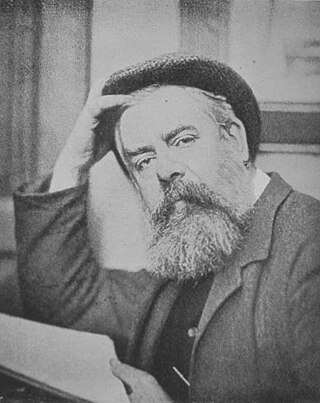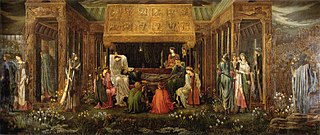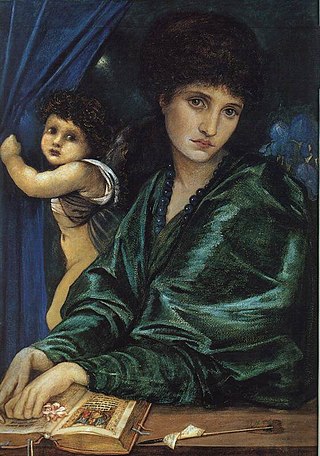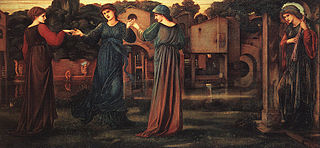
The Pre-Raphaelite Brotherhood was a group of English painters, poets, and art critics, founded in 1848 by William Holman Hunt, John Everett Millais, Dante Gabriel Rossetti, William Michael Rossetti, James Collinson, Frederic George Stephens and Thomas Woolner who formed a seven-member "Brotherhood" partly modelled on the Nazarene movement. The Brotherhood was only ever a loose association and their principles were shared by other artists of the time, including Ford Madox Brown, Arthur Hughes and Marie Spartali Stillman. Later followers of the principles of the Brotherhood included Edward Burne-Jones, William Morris and John William Waterhouse.

Sir Edward Coley Burne-Jones, 1st Baronet, was an English painter and designer associated with the Pre-Raphaelite Brotherhood's style and subject matter.

The Beguiling of Merlin is a painting by the British Pre-Raphaelite painter Edward Burne-Jones that was created between 1872 and 1877.

Frederick Hollyer was an English photographer and engraver known for his photographic reproductions of paintings and drawings, particularly those of the Pre-Raphaelite Brotherhood, and for portraits of literary and artistic figures of late Victorian and Edwardian London.

The Last Sleep of Arthur in Avalon is a painting by Edward Burne-Jones, started in 1881. The massive painting measures 279 cm × 650 cm, and is widely considered to be Burne-Jones's magnum opus.

The Star of Bethlehem is a painting in watercolour by Sir Edward Burne-Jones depicting the Adoration of the Magi with an angel holding the star of Bethlehem. It was commissioned by the Corporation of the City of Birmingham for its new Museum and Art Gallery in 1887, two years after Burne-Jones was elected Honorary President of the Royal Birmingham Society of Artists. At 101 1/8 x 152 inches, The Star of Bethlehem was the largest watercolour of the 19th century. It was completed in 1890 and was first exhibited in 1891.

Sponsa de Libano is a painting by the Pre-Raphaelite artist Edward Burne-Jones dated 1891.

Maria Zambaco, born Marie Terpsithea Cassavetti, was a British artist's model of Greek descent, favoured by the Pre-Raphaelites. She was also a sculptor.

King Cophetua and the Beggar Maid is an 1884 painting by the Pre-Raphaelite artist Edward Burne-Jones. The painting illustrates the story of 'The King and the Beggar-maid", which tells the legend of the prince Cophetua who fell in love at first sight with the beggar Penelophon. The tale was familiar to Burne-Jones through an Elizabethan ballad published in Bishop Thomas Percy's 1765 Reliques of Ancient English Poetry and the sixteen-line poem The Beggar Maid by Alfred, Lord Tennyson.

Pygmalion and the Image is the second series of four oil paintings in the Pygmalion and Galatea series by the Pre-Raphaelite artist Edward Burne-Jones which was completed between 1875 and 1878. The two collections may be seen below, in the Gallery, the first being now owned by Lord Lloyd Webber, and the second housed at the Birmingham Museum & Art Gallery. This article deals with an appraisal of the second series.

The Merciful Knight is a watercolour by the pre-Raphaelite artist Edward Burne-Jones which was completed in 1863 and is currently housed at the Birmingham Museum & Art Gallery.

The Flower Book by Edward Burne-Jones (1833–1898) is a series of 38 round watercolours, each about six inches across, painted from 1882 to 1898. The paintings do not depict flowers; rather, they were inspired by the flowers' names. Burne-Jones called them "a series of illustrations to the Names of Flowers". "Not a single flower itself appears", according to his wife Georgiana. They were painted for his private pleasure, many while he was resting at his summer home in Rottingdean, and were described by his wife as the "most soothing piece of work that he ever did". In 1905 Georgiana, by then a widow, published a limited edition of high-quality colour facsimiles.

Georgiana, Lady Burne-Jones was a painter and engraver, and the second oldest of the Macdonald sisters. She was married to the Late Pre-Raphaelite artist Edward Burne-Jones, and was also the mother of painter Philip Burne-Jones, aunt of novelist Rudyard Kipling and Prime Minister Stanley Baldwin, confidante and friend of George Eliot, William Morris, and John Ruskin. She was a Trustee of the South London Gallery and was elected to the parish Council of Rottingdean, near Brighton in Sussex.

The Golden Stairs is one of the best-known paintings by the Pre-Raphaelite artist Edward Burne-Jones. It began in 1876 and was exhibited at the Grosvenor Gallery in 1880.
Hope is a late oil painting by the Pre-Raphaelite artist Edward Burne-Jones. It was painted on commission for Mrs. George Marston Whitin of Whitinsville, Massachusetts in 1896.

The Nativity is one of a pair of monumental paintings by the Pre-Raphaelite artist Edward Burne-Jones commissioned for the chancel of the church of St John the Apostle, Torquay, England, in 1887. The Gothic Revival church was designed by architect George Edmund Street in the 1860s and decorated by Morris & Co., the decorative arts firm in which Burne-Jones was a partner.
Stephen Wildman is Professor of the History of Art at the University of Lancaster and Director of the Ruskin Library and Research Centre.

The Mill is an Aesthetic Movement, Renaissance-inspired oil on canvas painting completed by Edward Burne-Jones in 1882. The painting's main feature is three women dancing in front of a mill pond on a summer evening, with a vague wooded landscape spanning the background. The Mill is an oil on canvas painting. It is 91 centimetres (36 in) in height, and 197 centimetres (78 in) in width.

Victorian painting refers to the distinctive styles of painting in the United Kingdom during the reign of Queen Victoria (1837–1901). Victoria's early reign was characterised by rapid industrial development and social and political change, which made the United Kingdom one of the most powerful and advanced nations in the world. Painting in the early years of her reign was dominated by the Royal Academy of Arts and by the theories of its first president, Joshua Reynolds. Reynolds and the academy were strongly influenced by the Italian Renaissance painter Raphael, and believed that it was the role of an artist to make the subject of their work appear as noble and idealised as possible. This had proved a successful approach for artists in the pre-industrial period, where the main subjects of artistic commissions were portraits of the nobility and military and historical scenes. By the time of Victoria's accession to the throne, this approach was coming to be seen as stale and outdated. The rise of the wealthy middle class had changed the art market, and a generation who had grown up in an industrial age believed in the importance of accuracy and attention to detail, and that the role of art was to reflect the world, not to idealise it.

















